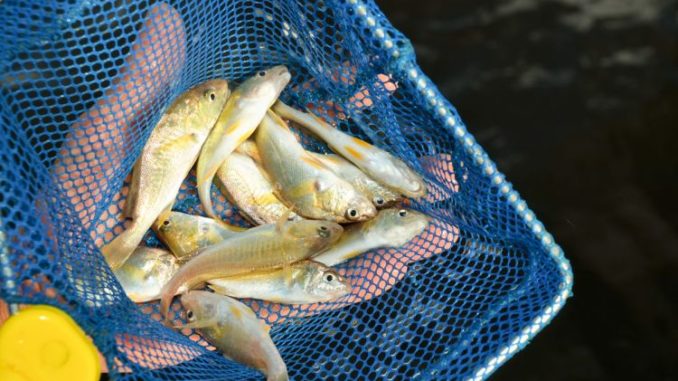
Capt. Ricky Trahan specializes in fishing with live croakers. Here are his tips to getting the most out of the bait.
• If a croaker isn’t wiggling, it doesn’t attract fish. A weak croaker will turn pale in color and isn’t active. Change baits often. If you don’t get a bite in 3 minutes, change the bait; something is wrong.
• Croakers can be kept alive overnight in a 94- or 120-quart ice chest by adding a couple of 2-liter bottles of frozen water to the chest to keep the water cool and by using two bubble-up aerators per ice chest.
• Trahan is a firm believer in using Pogey Croaker Saver bait-holding formula when he has to hold live bait overnight or for an extended period of time.
• While fishing, always run the livewell pump to circulate water from the outside. Turn off the pump to run from spot to spot. When you get to your destination, turn on the pump to pump new water into the well to freshen it.
• Dip out and discard dead or dying croakers from the livewell.
• Croakers can be caught trawling from May to the end of September. They are small at first, but they grow rapidly. Trahan’s favorite size is 2 to 4 inches long.
• Don’t keep other species to put in the livewell. Spots (aka sand diggers) don’t catch fish well. They are easy to spot while sorting the trawl drag by the spot on each side behind the head. Don’t keep shrimp unless they are large; large shrimp go in the ice chest for humans to eat.
• Unless croakers are very small, you must let the fish take the bait all the way. In other words, don’t set the hook on the first bump. Wait until the fish starts swimming with it — about 3 seconds. If you set the hook too early, you will miss the fish most of the time. The larger the croaker, the more important waiting is.
• Always use a dip net to get croakers from the livewell. Sunblock will kill them within 15 minutes after a treated hand goes in the well.
• While fishing, twitch the rod every few minutes to make the croaker on the hook move and croak.
• Croakers are trout crack. If you don’t get a bite in 20 minutes, move the boat.
• If fishing in water 8½ feet deep or shallower or in an area with lots of rocks and debris on the bottom, croakers are best fished free-line. If water currents are strong, one or two split shot can be added to the line 12 inches above the bait.
• When fishing at the short rigs, it is best to use a Carolina rig with a ¼- or ½-ounce weight to get the bait quickly past toothy predators to the bottom.
• Croakers telegraph when a trout approaches. It feels like they are getting nervous; get ready for a hit when you feel that.
• Croakers have a strong habit of diving into rocks. Try twitching the rod tip to tease them out of the rocks before breaking the line off.